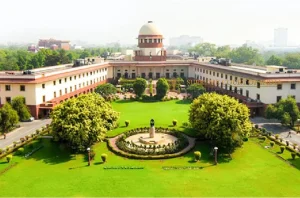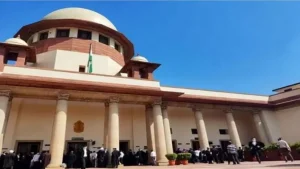

Should The Central Selection Mechanism For The Appointment Of Subordinate Courts Judges Be Implemented?
- /
- Articles and Blogposts /
- Should The Central Selection Mechanism For The Appointment Of Subordinate Courts Judges Be Implemented?
An overwhelming number of judicial positions in subordinate court are vacant and the Supreme Court is pressuring state authorities and the High Courts to fill these vacancies. The Court has sought their opinion on establishing a central selection system for appointing district judges.
The staggering number of vacancies of judges in subordinate courts across India has been on the Supreme Court’s radar for a while, to the point that the Chief Justice of India in November 2018 said ‘enough is enough – if the States are not going to appoint judges, the Supreme Court will’. The Chief Justice’s outburst is completely justified considering that there are currently 5133 vacant posts out of the sanctioned strength of 22036 judicial posts in the subordinate courts. Out of these 5133 vacancies, for 1324 posts the recruitment process has not been initiated.
Delay in judicial appointments
Subordinate court judges are appointed by the Governor of the concerned state after consulting with the respective High Courts. However, judicial positions in many lower courts are currently vacant because the procedure of appointment has been delayed or the notification for initiating the process of recruitment has not been issued. The recruitment of judges is a three-step process involving:
(a) a written preliminary examination,
(b) a written main examination, and
(c) an interview.
Candidates who clear the written exams as well as the interview are short listed for being appointed as judges. The Supreme Court in the case of Malik Mazhar v. U.P. Public Service Commission, held that the process of recruitment, which starts from the date of issue of the advertisement and culminates with date of appointment, should be completed in 153 days for Junior Civil Judges and 273 days for District Judges. This directive is being sidestepped across the country. The Delhi High Court released the final results of the Delhi Judicial Services examination – 2017 on 30 January 2019, to fill up 50 vacancies in the lower judiciary. The High Court took 403 days to finish the recruitment process.
Vidhi Centre for Legal Policy in its study on the recruitment cycle for the appointment of Civil Judges (Junior Division) and District Judges for various states found that appointments to lower courts were delayed because of the lack of adequate infrastructure and man-power to conduct the examinations and the lack of awareness among potential candidates about the release of advertisements for these examinations. On some occasions, no candidates were selected despite an examination having been conducted due to a dearth of meritorious candidates.
The Supreme Court has now asked all the High Courts in the case of Re: Filling up of vacancies, why they are taking so long to appoint judges, when the recruitment processes are going to finish, and has asked them to furnish information for reasons of delay. The Court is trying to understand why if the appointment process is taking longer than the stipulated timeline and to understand what should be the ideal timeline for the process to be completed. Further, the Court has also sought information about whether notifications have been issued for filling the current vacancies, and the availability of infrastructure for the recruitment process.
New system to combat delay
The Supreme Court is pursuing the filling of vacancies as its top-most priority and has taken suo-moto action in the case of In re Central Selection Mechanism for Subordinate Courts to get the opinion of various High Courts on centralization of the appointments of District Judges. The idea is to bring the ambit of judicial examinations under one centralized system and provide a pool of judges for the state to select from without affecting the state’s power to appoint judges.
Some of the features of the proposed system are:
- A centralized system with one exam held throughout India which would provide more certainty to the selection process. This would attract young legal minds and incentivize them to consider the subordinate judiciary as a prospective career option.
- The examination for entry will be held at periodic intervals with a prescribed syllabus as opposed to the current system where state authorities have limited or no information on the format or syllabus of the examination.
- A single exam is conducted which will make it easier to prepare a universal merit list for states to select from.
- A national and state-wise rank lists will ensure that the states’ categories for reservation and specific criteria of state language and laws would apply to the candidates under the new system. This is to ensure that the power of the Governor to appoint subordinate judges, in consultation with the concerned High Courts, is not taken away by the introduction of this system.
- A central selection committee with a five member body as advised by the CJI with the task of framing policies and overseeing the functioning of the Central Selection Mechanism.
The centralized system appears to be an appealing and easy solution for filling up vacancies in the subordinate judiciary, but this system will dilute the provisions of Articles 233 – 237 of the Constitution. These provisions mandate that the state and the High Courts have exclusive powers to conduct and choose the method of selection of lower court judges. The Supreme Court cannot limit the powers of the state and High Courts through what is in effect a constitutional amendment.
The proposed new system assumes that vacancies arise only due to the delay in appointing judges. The problem however, is more nuanced. The suggestion for the new selection method is being opposed by many lawyers and academicians on the ground that the reason for judicial vacancies is not only due to the delay in appointments but also, low salaries and poor reputation of the lower judiciary.
It is not desirable to have a straightjacket approach towards this issue. A centralized system may not be viable since the challenges faced by different states are different and thus selection methods should be tailored to the needs of each state. Different states also have varying requirements regarding the required judge strength, because smaller states need fewer judges than the bigger ones. The non-availability of proper infrastructure to conduct these examinations also affects each state differently.
Implementing the proposed Centralized Selection Mechanism would merely be a Band-Aid on a deep cut. Hence, in order to solve the problem of judicial vacancies in subordinate courts, a detailed study needs to be conducted to understand why there are insufficient meritorious candidates, the reasons for lack of proper infrastructure and manpower in conducting the qualifying examination, and most importantly why many young lawyers do not want to enter the lower judiciary.
[ReviewDisclaimer]

Amulya Ashwathappa
RECENT ARTICLES


Lessons for Judiciary from Space Sector

The missing piece in India’s reform story—a strong tribunal system

Fast-track courts may not be the cure

-
Rule of Law ProjectRule of Law Project
-
Access to Justice SurveyAccess to Justice Survey
-
BlogBlog
-
Contact UsContact Us
-
Statistics and ReportsStatistics and Reports
© 2021 DAKSH India. All rights reserved
Powered by Oy Media Solutions
Designed by GGWP Design